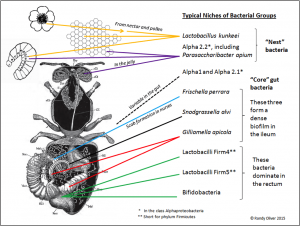Ever wonder about the impact of heavy, year-to-year applications of glyphosate-based herbicides on wildlife and ecosystem food chains? Environmental Health News provides some key, fresh insights in “What’s the world’s most widely used herbicide doing to tiny critters?”
We already know that glyphosate and other pesticides have become ubiquitous in streams and groundwater, suggesting ecological impacts are likely to be occurring. Indeed, we have reported here on Hygeia on how glyphosate impacts the gut bacteria of honeybees and has been implicated in monarch butterfly declines.
The new piece points out that glyphosate use has skyrocketed over the last three decades. In the 1980s, farmers used only around 11 million pounds annually, but today spray approximately 300 million pounds on U.S. crops each year – over a 2,600% increase! The main reason for this spike in use is the introduction and widespread adoption of glyphosate-resistant crops, a technological “innovation” that reached the market in 1996.
“Glyphosate residues can stick around in water and soil for several months, maybe even years. That means it has the potential to build up to higher levels in the environment with each use” (Konkel, 2019). In the 20+ years since herbicide-resistant crops were introduced, glyphosate levels in the environment have risen in many areas. And now, scientists are starting to see evidence of the toll is is taking on wildlife.
“In aquatic and terrestrial environments, researchers have linked changes in metabolism, growth, behavior and reproduction of certain fishes, mollusks and insects with exposure to glyphosate-containing herbicides” (Konkel, 2019), such as:
- Mosquito larvae exposed exposed to a level of glyphosate similar to what is found in the environment showed cognitive impacts that affected their ability to recognize potential dangers.
- Bees also seem to suffer developmental impacts from herbicide use, glyphosate exposure increased the amount of time it took for them to find their hives, which “could have long-term consequences for colony health.”
- Several studies have documented evidence of cellular damage and reproductive toxicity from glyphosate in mussels, crayfish, and other aquatic invertebrates.
Impact on the Microbiome

An important element of new science on glyphosate impacts is focused on how an herbicide thought to only work on plants is also causing harm to the microbiome of some animals.
Glyphosate works by blocking the shikimate pathway in plants. A series of chemical reactions occur within the shikimate pathway that help synthesize key plant regulatory compounds (folates and aromatic amino acids).
While this process is not found in animals, leading to the assumption that glyphosate is not toxic to non-plants, scientists are finding that some of the gut bacteria and fungi that are part of the microbiomes of many organisms do rely on the shikimate pathway for survival.
The bee studies we reported on last year raised concerns that glyphosate may be affecting the microbiome in some animals. But, little research has yet been done. Also – healthy soils need a diverse soil microbiome. Is glyphosate impacting some of these tiny critters too?
This Environmental Health News story leaves us with almost as many questions as answers, along with a lot of red flags about possible hidden dangers of glyphosate-based herbicide use. We already know that prenatal glyphosate exposures may be impacting babies, and now we learn it may also be hurting our birds and our bees, and the intricate ecosystems within which they live.
The basic message in Konkel’s piece is that recurrent, widespread use of a pesticide with broad-based impacts, some known and understood, others just emerging, deserves much more attention, and in some cases, remedial interventions to slow the ecological bleeding. See the accompanying blog “Dealing with Roundup’s Mammoth — and Growing — Ecological Footprint” for why federal pesticide law will have to be reformed for that to happen.
Source:
Lindsey Konkel, “What’s the world’s most widely used herbicide doing to tiny critters?,” Environmental Health News, Date published: March 18, 2019, Date accessed: March 19, 2019.

